The inspiration for this article series was provided by Vera Meyer in her presentation entitled “The Front Garden” to Permaculture Sydney west (7/2/2022)
While delawning your front yard can be a 'one and done' exercise, in most cases it occurs over time with people gradually rplacing the lawn with other things, and the journey is ongoing. Also, depending on the delawners requirements, some lawn may be left for specific purposes such as recreation and play.
Following are some examples of how some people have delawned their front yard-
Here at the Choko Tree we have been de-lawning our front yard for years. It is a medium sized front lawn with an area of about 250m2, but it has enabled us to do quite a bit. To improve the productivity (among other things) our focus has been on perennials but that does not have to be the case for everyone and others have made use of annuals, as will be discussed later on –
The Choko tree currently has the following productive plants in its front yard –
• Over 20 productive trees and bushes including fruit trees such as various citrus, olive, apples, mulberry, feijoa. Fig, coffee and nectarine trees as well as productive leaf trees such as bay, curry leaf (murraya Koenigii) and kaffir lime (makrut).
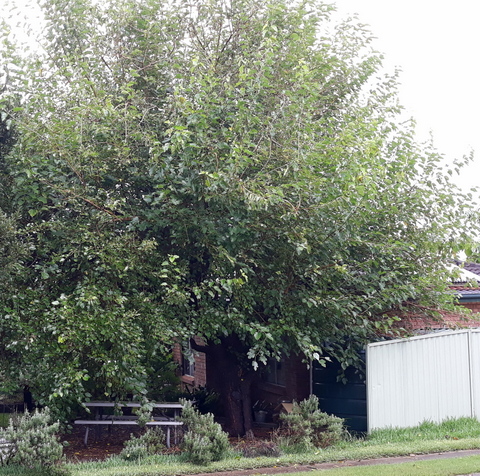
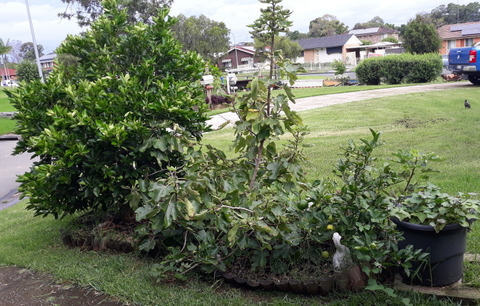
• Native trees and bushes such as lillypilly, tea tree (melaleuca alternifolia), banksia, midyin berry and callistemons.
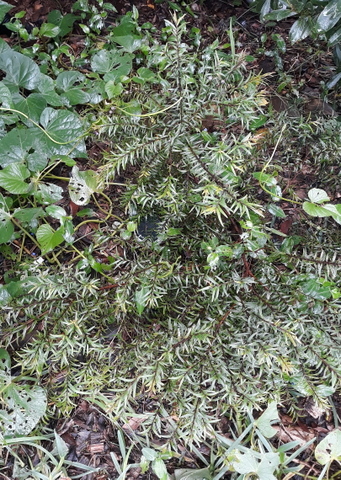
• Perennial vegetables such as sweet potato, asparagus, taro, rhubarb, Okinawa spinach and spring onions.
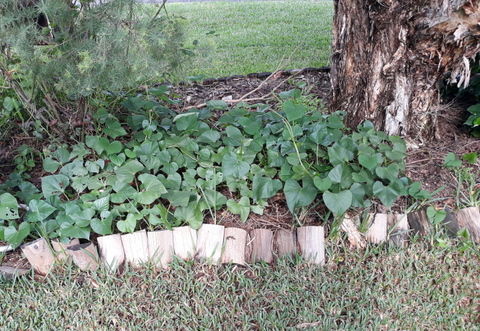
• Herbs such as tarragon, oregano, basil, lemongrass, rosemary, lavender and feverfew.
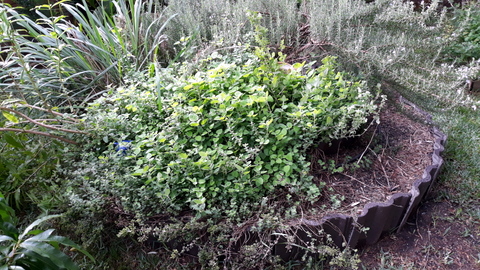
• A selection of annual insectary flowers that varies with the seasons.
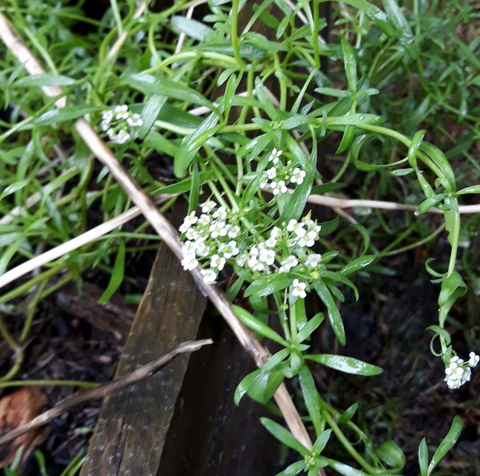
• Other miscellaneous useful plants such as native indigo, comfrey, thornless blackberry and macadamia nut.
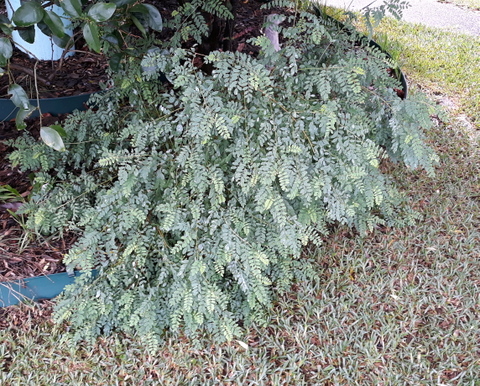
To address the issue of biodiversity, check out the plant list above! The larger trees including the mulberry, tea trees, olive, macadamia, curry leaf, lilly pilly and bay trees have created habitat for birds and our place is a bit of an oasis attracting a number of bird species. The flowering plants such as the insectary bed, melaleucas, lavender and the fruit trees attract a variety of insect pollinators and predators. To support the increase in biodiversity, we have also installed in the front yard two microbat roost boxes, a native bee hive, a self-watering bird bath and self-watering insect watering station.
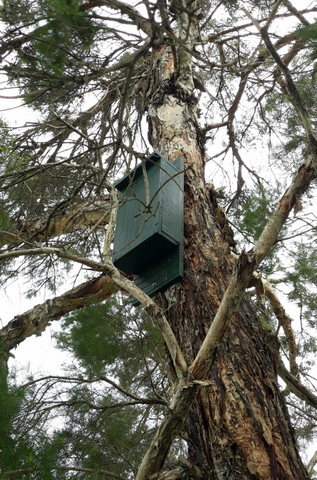
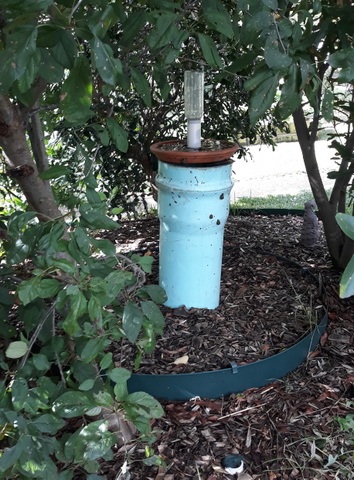
In terms of community, the growing part of our front yard has given us plenty of opportunities for discussion with friends, neighbours and passers-by about the various unusual plants we are growing. We have also installed a street library and community bench at the very front of our front yard for the use of anyone who wants or needs those facilities, and they both get regular use.

One of the by-products of our plantings over the years has been that with the large number and dense plantings of tall growing trees has been that when we look out or front windows, we mostly see green. The lounge room windows look out onto the fruit tree circle such that it is mostly what we see; and the bedroom windows, rather than looking out onto unbroken suburbia, provide us first with a view of many layers of plants with suburbia only being in the background.
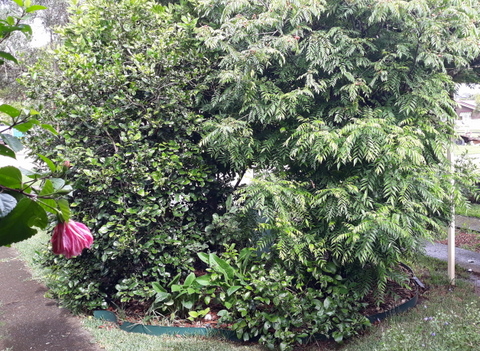
One of our early efforts at de-lawning as a strategy was to create a park-like area underneath the large mulberry on the northern boundary of the front yard. We covered the area with wood chips and installing a table/bench and kiddie swing. (Unfortunately during Covid, the swing has not had as much use as we would have liked).

By providing more privacy and productivity, the trees in and around our front lawn have also reduced the heating effect of the summer morning sun, providing lower summer temperatures in the front yard. The big mulberry provides shading or the two northern bedrooms, generally resulting in reduced temperatures in those bedrooms particularly in the morning.
One other project which has certainly had a de-lawning effect, even if that was it its primary intent, has been the locating of over half (10,000+ litres) of our rain water storage capacity in our front yard. This not only reduces lawn area but means that we have sufficient water storage that goes a long way towards maintaining hydration for our front yard plants without need to use the reticulated water supply.
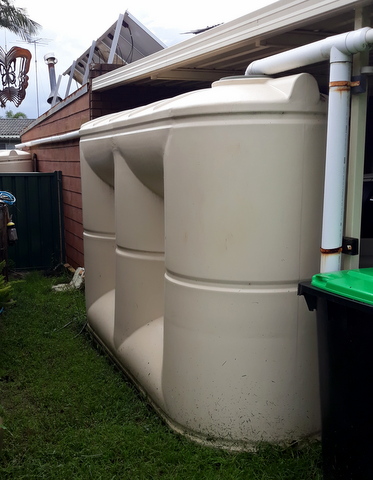
Greg and Vera Meyer (yes that Vera Meyer)
They are permaculture superstars have been delawning for years. Their suburban front lawn is only 12m2 but they have made it remarkably productive while still retaining an area for parking required by their vehicle.
Their front yard is planted with annual vegetables such as cherry tomatoes and pumpkins on occasion (and in no particular rotation); perennial fruits including citrus, mulberry and apricot as well as herbs such as fennel, Asian mint, basil and turmeric. To improve biodiversity, as well as the above productive plants, they have flowers for the bees and other pollinators such as alyssum and marigold and a couple of ponds providing water source for insects and frogs.

They also have some ornamental plants (buxus and jacaranda) which are pruned to provide organic matter, act as a scaffold for climbing productive species and to provide pleasant outlook and privacy. They use passionfruit, grown on a trellis covering the western side of the veranda, to reduce the heat of the summer sun coming into the house.
.jpg)
One other benefit of such a productive front yard has been the opportunity that it has created to share the fruits of their labour and their experience with neighbours and people walking past. Their front yard is such a beautiful and productive space that it easily attracts the attention of people in the area and opens opportunities for providing interaction with their local community.



Angie and Deniz
These two are comparatively new to the game but show what can be achieved in a relatively short time. The have a terraced, two level lawn and they have de-lawned the lower terrace which is approximately 75m2. They have also gone with a mixture of perennials and annuals.
Perennials include: various productive trees including citrus, a cherry and a curry leaf; herbs including dill, (lots of) comfrey, oregano and lemongrass. Rhubarb and a passionfruit vine are also included. Annual veg includes various brassicas, zucchini and tomatoes.
Before starting

As things develop
Later on
Delawning Your Front Yard - Part 1: What?, Why?
Delawning Your Front Yard - Part 3: Tips for your Own De-lawning project












